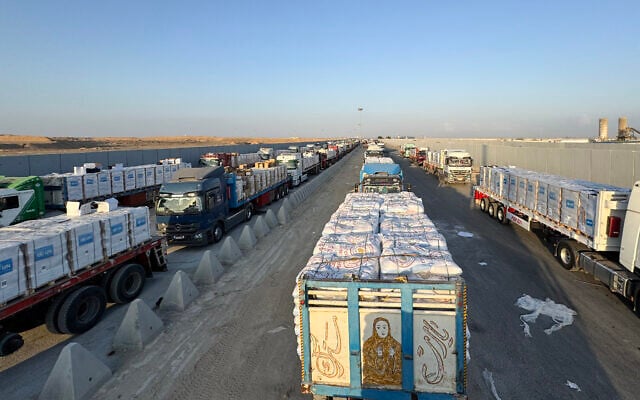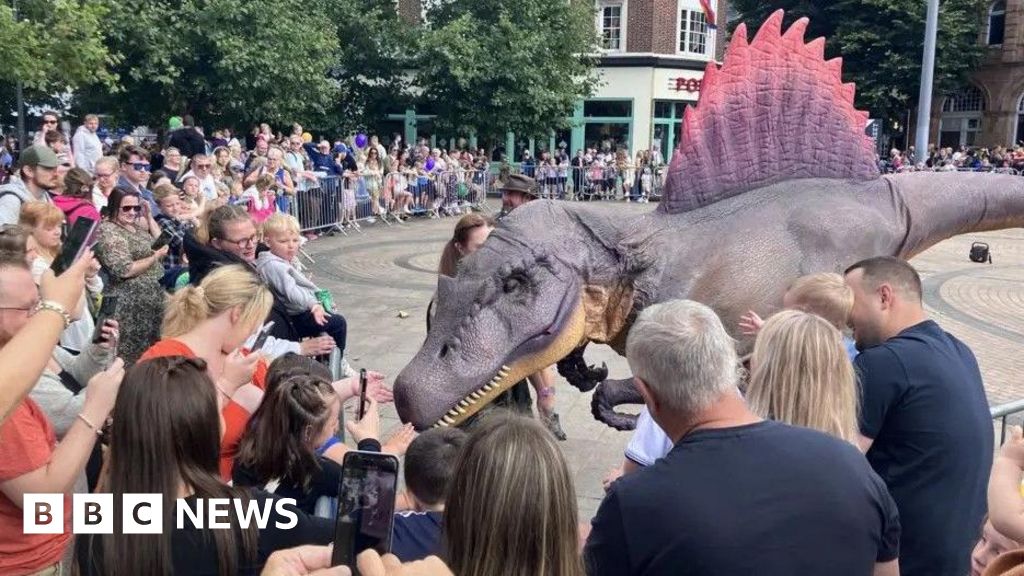At least 40 Palestinians were killed by Israeli gunfire and airstrikes on Gaza on Monday, including 10 seeking aid, Hamas-run health authorities in the enclave said, adding that another five had died of starvation amid what aid groups say is a severe humanitarian crisis. There was no immediate comment from the IDF.
The 10 who were killed near aid sites were reportedly killed in two separate incidents near facilities belonging to the US- and Israeli-backed Gaza Humanitarian Foundation in the Strip’s center and south, local medics said. Media outlets in Gaza also reported on Monday that Udai al-Quran, a nurse at Al-Aqsa Martyrs Hospital in Deir al-Balah, died after an aid package that was airdropped over the Strip hit him on the head.
The reported casualties came after Prime Minister Benjamin Netanyahu’s office said the cabinet is set to decide this week whether to expand the Israel Defense Forces’ ground operations in Gaza or to restrain military action in order to allow more time to reach a potential ceasefire and hostage release deal with Hamas.
“We must continue to stand together and fight together in order to achieve” the war’s goals, Netanyahu said in remarks shared by his office, specifying the war’s goals, as he has many times before, as “the defeat of the enemy, the release of our hostages, and ensuring that Gaza will never again pose a threat to Israel.”
Last week, the IDF withdrew some troops from Gaza. On Sunday, four IDF soldiers were wounded, one of them seriously, in a car crash during operational activity near the border with the Strip. And on Monday, more than a dozen former senior security officials put out a joint video calling to end the war, arguing that Israel was racking up losses, and that the fighting has dragged on for political reasons.
Get The Times of Israel’s Daily Edition
by email and never miss our top stories
By signing up, you agree to the terms
Netanyahu insisted on Sunday that Hamas is uninterested in a deal, which creates an incentive to “destroy” the terror group.
Negotiations between the sides reached an impasse in late July. But pressure on the government to free the hostages has remained heavy following the publication last week of videos showing two of the captives, Rom Braslavski and Evyatar David, in emaciated condition. Gaza terror groups are holding 50 hostages, at least 20 of whom are thought to be alive.
A still of hostage Evyatar David taken from a Hamas propaganda video (left) released on August 1, 2025. (Hostages and Missing Families Forum)
On Sunday, Netanyahu’s office said he spoke to Julien Lerisson, the regional coordinator of the International Committee of the Red Cross, and “requested his involvement in providing food to our hostages and… immediate medical treatment.”
The ICRC said in a statement it was “appalled by the harrowing videos” and reiterated its “call to be granted access to the hostages.”
In response, Hamas said it would allow the agency access to the hostages but only if “humanitarian corridors” for food and aid were opened “across all areas of the Gaza Strip.”
The Red Cross has not provided any assistance to the hostages since the outbreak of the war on October 7, 2023, apart from facilitating the transfer of captives during two truce periods.
Humanitarian groups continue to sound the alarm over widespread starvation in Gaza and increasing reports of deaths due to malnutrition. The United Nations says more than 1,300 people have been killed trying to obtain aid supplies in the enclave since the GHF began operating in May 2025, most of them shot by Israeli forces operating near GHF sites.
The IDF has acknowledged firing warning shots at crowds that get too close to its soldiers but called the UN tallies exaggerated, though it hasn’t provided alternate numbers.

Displaced Palestinians carry food parcels and supplies from a GHF aid distribution point in central Gaza, August 4, 2025. (Ali Hassan/Flash90)
The GHF began operating in May after a nearly three-month aid blockade Israel had imposed on the Strip. The group seeks to circumvent Hamas in the distribution of aid, amid Israeli allegations that the terror group regularly hijacks deliveries under the existing UN-led aid system. The UN and other aid groups have rejected the GHF, accusing it of violating humanitarian principles of neutrality and of putting aid seekers in harm’s way.
“Everyone who goes there, comes back either with a bag of flour or carried back (on a wooden stretcher) as a martyr, or injured. No one comes back safe,” said 40-year-old Palestinian Bilal Thari.
He was among mourners at Gaza City’s Al Shifa hospital on Monday who had gathered to collect the bodies of their loved ones killed a day earlier as they sought aid, according to local health officials.
At least 13 Palestinians were killed on Sunday while waiting for the arrival of UN aid trucks at the Zikim crossing on the Israeli border with the northern Gaza Strip, the officials added.
At the hospital, some bodies were wrapped in thick patterned blankets because white shrouds, which hold special significance in Islamic burials, were in short supply due to continued Israeli restrictions on the entry of supplies, and the mounting number of daily deaths, Palestinians said.
“We don’t want war, we want peace, we want this misery to end. We are out on the streets, we all are hungry, we are all in bad shape, women are out there on the streets, we have nothing available for us to live a normal life like all human beings, there’s no life,” Thari told Reuters.

Displaced Palestinians carry bags of humanitarian aid they received at a distribution center run by the US- and Israeli-backed Gaza Humanitarian Foundation (GHF) at the “Netzarim corridor” in the central Gaza Strip on August 4, 2025. (Photo by AFP)
Meanwhile, five more people died of starvation or malnutrition over the past 24 hours, Gaza’s Hamas-run health ministry said on Monday. The new deaths raised the toll of those dying from hunger to 180, including 93 children, since the war began.
Israel has denied allegations of widespread starvation in Gaza and blamed the UN and Hamas for obstructing or diverting aid meant for civilians. In late July, the government instituted a series of measures to alleviate hunger in the Strip, including airdrops and 10-hour “humanitarian pauses” in military operations in three population centers.
On Monday, Australia announced that it would provide an additional $20 million in humanitarian aid for Gaza, following growing domestic pressure and mass pro-Palestinian protests in Sydney demanding increased aid for Gazans and sanctions on Israel.
The new package will fund food deliveries, medical supplies for field hospitals, and other critical support, with a focus on women and children, the Australian Foreign Ministry said.
“The suffering and starvation of civilians must end,” said Australian Foreign Minister Penny Wong, adding that “Australia will continue to work with the international community to call for an immediate and permanent ceasefire, the release of hostages and a two-state solution.”
And Germany’s interior ministry is reviewing whether it can bring children from Gaza to Germany for treatment, a ministry spokesperson said. The German cities of Hanover and Düsseldorf have said in recent days that they would accept children from Gaza and Israel who are particularly vulnerable or traumatized.

Trucks loaded with humanitarian aid await permission on the Egyptian side of the Rafah crossing with the Gaza Strip, August 3, 2025. (AFP)
COGAT, the Israeli agency that coordinates activity in the West Bank and Gaza, said on Sunday that 23,000 tons of humanitarian aid on 1,200 trucks entered Gaza over the past week, and that 1,200 trucks were “successfully collected by the UN and international organizations.”
Nevertheless, it added, “hundreds of trucks remain inside Gaza, waiting to be picked up and distributed by the UN and international organizations.”
That aid was separate from the “hundreds of pallets of humanitarian supplies” that have been airdropped into Gaza recently, it added.
On Monday, aircraft from Jordan, the United Arab Emirates, Egypt, Germany, Belgium, and — for the first time — Canada, airdropped 120 pallets of humanitarian aid in the northern and southern Gaza Strip, the IDF said.
Each pallet contains around one ton of food.
The IDF said the airdrops were carried out “in accordance with the directives from the political leadership and as part of the cooperation between Israel” and the involved countries.
“The IDF will continue to work in order to improve the humanitarian response in the Gaza Strip, along with the international community, while refuting the false claims of deliberate starvation in Gaza,” it added.

Palestinians rush to collect humanitarian aid airdropped by parachutes into Zawaida in the central Gaza Strip, Monday, Aug. 4, 2025. (AP Photo/Abdel Kareem Hana)
Since July 26, a total of 675 humanitarian aid packages have been airdropped in the Gaza Strip by nine countries, including Israel. The packages the IDF airdropped were supplied by international aid groups, not by Israel.
UN agencies have said that airdrops of food are insufficient and that Israel must let in far more aid by land and quickly ease access to it. Palestinian and UN officials said Gaza needs around 600 aid trucks to enter per day to meet the humanitarian requirements of the Strip, the number Israel allowed into Gaza before the war.
The war began with the Hamas-led October 7, 2023, attack on Israel, which killed some 1,200 people and took more than 250 hostage. Since then, the Hamas-run Gaza health ministry says more than 60,000 people in the Strip have been killed or are presumed dead in the fighting, though the toll cannot be verified and does not differentiate between civilians and fighters.
Israel says it has killed some 20,000 combatants in battle as of January and another 1,600 terrorists inside Israel during the October 7 onslaught. Israel has said it seeks to minimize civilian fatalities and stresses that Hamas uses Gaza’s civilians as human shields, fighting from civilian areas including homes, hospitals, schools, and mosques.
Israel’s toll in the ground offensive against Hamas in Gaza and in military operations along the border with the Strip stands at 459. The toll includes two police officers and three Defense Ministry civilian contractors.










